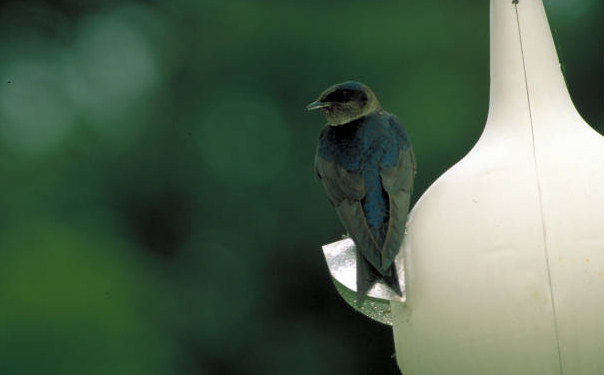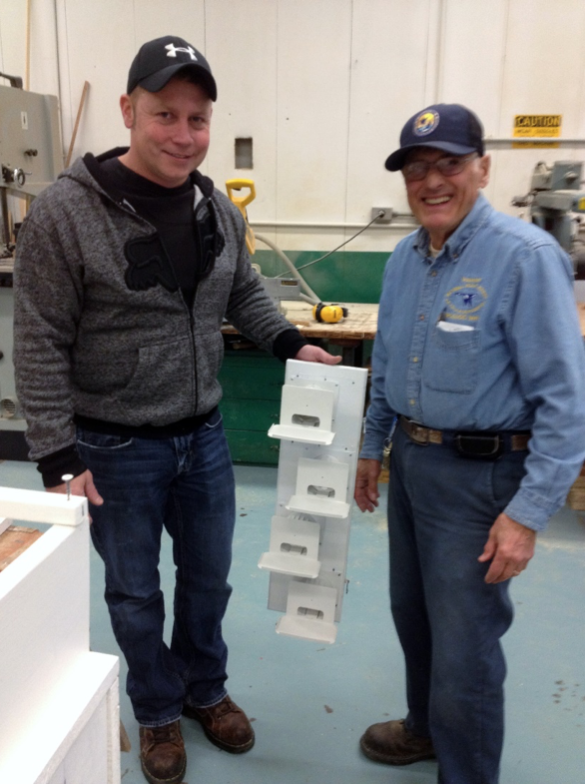
The New York State Purple Martin Project is a collaborative effort of partners dedicated to educating and engaging citizens in the conservation of Purple Martins, with the goal of increasing martin populations throughout New York State. Our vision began in 2012, to support the Purple Martin Conservation Association activities in New York State and establish a Purple Martin landlord database, linking landlords with our organization, to promote best Purple Martin housing and management practices throughout New York State. We are thankful for getting our generous support from donors like you and the Friends of Iroquois National Wildlife Refuge. Read on to find out about Purple Martins, our projects and to see what we have accomplished with your support!

Range wide, from Rocky Mountains eastward, Purple Martins (Progne subis) are holding their own, although the population has declined in comparison to records from before the 1970’s. In New York State, the picture is far bleaker.
From data gathered from the first New York State Breeding Bird Atlas of 1980-1985, heavy concentrations of Purple Martins were confirmed to be nesting in the areas along the St. Lawrence Seaway, the Great Lakes, inland lakes, at our two National Wildlife Refuges and on Long Island. Martins tend to avoid mountainous and urbanized areas of New York.
During the second New York State Breeding Bird Atlas of 2000-2005, Purple Martin breeding was confirmed in far fewer blocks, within those same preferred areas. In fact, martins were confirmed in the first breeding bird survey in 618 versus 338 blocks in the most recent breeding bird survey, resulting in a change of -45% in breeding blocks confirmed. Taking into account possible, probable and confirmed changes, martin breeding success was rated at -39%. Another worrisome statistic from the NYS Breeding Bird Atlas II is that since the 1970’s, New York Purple Martin populations have declined by an alarming 60 percent.

As measured by the annual Buffalo Ornithological Society May bird count, in the Western New York region, the densest Purple Martin populations are on the south shore of Lake Erie, on Grand Island, along Lake Ontario from Newfane to Point Breeze, near Bethany, and near Lake Chautauqua. The number of martins observed has fluctuated widely on the May Count, but mirrors the decline in the entire state since 1960.
Why have the Purple Martins declined? They haven’t moved elsewhere, because martins are very site specific, returning to their natal colonies year after year. There are many possible factors that have contributed to the decline of our martins:
- Loss of Habitat or Change in the Habitat
- Lack of Housing-Fewer Purple Martin landlords because of less interest in Purple Martins and Birds in General
- Improper Management of Housing including not controlling the non-native species that compete for cavity space those being European Starlings and (English) House Sparrows
- Lower Survival in Migration or in Wintering Areas

Knowing all this we looked to Montezuma National Wildlife Refuge for inspiration, where state of the art housing and proper Purple Martin management was well underway. The colony at Montezuma was established in 2009 guided by Purple Martin enthusiast Rick Marx, with two T-14 wooden houses each with 4 Troyer horizontal gourds (all with Starling excluder entrances).
At Savannah, NY, Rick Marx also assisted in installing similar housing at the Montezuma Audubon Society building. This colony was established in 2010 with one T-14 wooden house with 4 Troyer horizontal guards (all with Starling excluder entrances). A second T-14 wooden house with 4 Troyer horizontal guards (all with excluder entrances) was added for the 2011 nesting season.
At Iroquois National Wildlife Refuge, we got busy and with INWR staff started modifying an existing site at the Job Corps, which had a Purple Martin colony in need of help. The site had two T-14 wooden houses that had been installed as a result of an Eagle Scout Project by Evan Morien of Medina NY, who led Job Corps students at the wood shop in constructing and installing the housing and their poles. Our team added a third wooden house and made many modifications since then, including:
- Predator guards and locks to prevent intrusions by mammals and snakes.
- Winches which allow the housing to be raised and lowered as often as needed
- Decoys for new sites to attract martins. A Purple Martin decoy is attached with a very small hose clamp assembly to a wooden block which can be moved around on the Purple Martin housing to simulate occupancy, making the housing more attractive to unattached martins.
- Troyer Horizontal and Vertical Plastic Gourds with wing guards that prevent entrapment of martins, have separate porches that prevent competition among martins and have runways for secure footing.
- Tunnel Entrances: We eventually switched all of our housing to tunnel entrances. Starlings cannot easily enter. House Sparrows can be trapped. We find that strips of hanging Mylar tape reduces non-native competition problems.
- Trays In all our wooden housing to easily view the nest without disturbing it. In April we add White Pine needles for bedding in all our housing. Pine needles are warm and stay dry. The martins will add their own bedding.
Because the Job Corps site became very popular with the Martins, we added for a total of five public sites listed here!
- Tonawanda WMA Tops Pond, Lewiston Road at Meadville Road, Basom: Started in 1990s – New T-14 wooden house installed in 2010. Very successful.
- Tonawanda WMA Mud Creek Marsh, Lewiston Road at Griswold Street, Middleport: New T-14 wooden house installed in 2016. Doing well.
- INWR Headquarters, Casey Rd. Basom: Original Colony declined in 1990s – New T-14 wooden house installed in 2010 – A gourd rack was added in 2014; Second donated gourd rack installed by the INWR Headquarters Trail in 2016. A research site, equipped with nest cameras.
- INWR Job Corps, Tibbits Road, Medina: Three T-14 wooden houses with eight gourds each and two additional gourd racks. This is the original colony which got us started and is our largest burgeoning colony!
- Oak Orchard WMA Goose Pond Overlook, Albion Road, Oakfield: Two T-14 houses with eight gourds each, fully complete in 2018.

Martins instinctively make their nest cup as deep in the provided cavity as possible. Both male and female martins make the nest. Martin nestlings will have plenty of room to exercise their wings for stronger first flights in our deep wooden cavities and our roomy gourds. After the female martin incubates the clutch of eggs for 15-18 days, it is finally hatching day. All chicks in one clutch usually hatch within 24 hours of each other.
Record Keeping is very important. We keep careful records of each cavity’s nest condition, number of eggs, number of young, band numbers and number of fledged young. These are recorded weekly and reported to the US Fish and Wildlife Service and the Purple Martin Conservation Association. We have an avid team of volunteers, as well as Youth Conservation Corps students who learn valuable skills while working at Iroquois, who assist in weekly checks and banding. Every martin chick between 12 and 18 days of age and any adult we happen to find in a cavity is banded. When the season is nearing an end, we use a gourd plug apparatus to temporarily plugs holes of chicks susceptible to early fledging. This prevents older nestlings from jumping the nest prematurely, while we are banding the younger chicks.
You might wonder how we are doing at INWR. We publish our fledged numbers every year on this website. Look for our chart at the bottom of this page. In 2019, we fledged 356 Purple Martins at INWR and 346 at State WMAs! That’s a total of 702 young martins! Every year we hold a banding demonstration program that is advertised on the Iroquois Observations schedule, also available on our website.

We have partnered with:
- Darien Lake State Park- started by NYSPMP volunteer David Seiferth, in 2013, who with his own funding erected a wooden house he made himself along with 8 plastic gourds. Four pair fledged 16 young in 2013. The colony was monitored by Abigail Bradley, Park Intern and David. Abigail wrote an article about her experiences which was published by the Purple Martin Conservation Association in their magazine, Purple Martin Update. In 2014, with funding from the New York State Bluebird Society, a 24-unit gourd rack was added. Plastic horizontal gourds were modified with elbows to reduce condensation problems. The colony fledged 66 young in 2014 and continues to this day.
- Batavia Waste Water Treatment Plant Treadeasy Drive – Established in fall, 2014, opened spring 2015 in coordination with the Buffalo Ornithological Society. New Gemini 24 Gourd Rack. It’s going strong and has been full of Purple Martins since 2017!
- Arrowhead Golf Course, Akron NY- 2014 Began assisting owners with Horizontal Gourds in 2014. Increased productivity to 42 fledged martins. Outdated housing was modified in 2016 to eliminate House Sparrow and European Starling problems. Still producing!
- NYSPMP and Buffalo Ornithological Society hold a September Field Trip to Buckhorn Island SP Grand Island, NY to a Purple Martin Roost. This is the Grass Island, a reed bed unique in the Niagara River system. The “Grass Island” is within the designated Niagara River Important Bird Area and is a Wetland of International Importance designated by the Ramsar Convention in 2019. This martin roost relocated to the Niagara Peninsula of Canada in 2019, perhaps due to human activity at Grass Island.
Please consider generously supporting our efforts to reverse the decline of our largest swallow, this beautiful aerial insectivore, the Purple Martin!
Send donations by clicking the link to our donation page!
– or –
The USPS will deliver your donation to:
Friends of Iroquois NWR, Inc.,
1101 Casey Road
Basom, NY 14013






